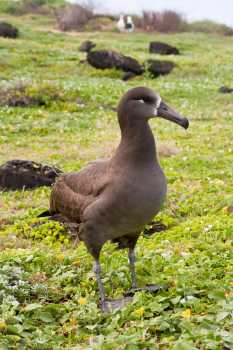Thuruthippallil Leena Mol (Center for Marine Environmental Studies, Ehime University, Matsuyama, Japan) and colleagues writing this year in the journal Environmental Science and Technology have looked at the levels of dioxins (one of the "dirty dozen" of chemicals known as persistent organic pollutants, or POPs) in Black-footed Albatrosses Phoebastria nigripes.
The paper's abstract follows:
"Our previous studies have detected high levels of dioxins and related compounds (DRCs) including polychlorinated dibenzop-dioxins (PCDDs), furans (PCDFs), and coplanar PCBs (Co-PCBs) in the black-footed albatross (BFA), Phoebastria nigripes, from the North Pacific region. We have also cloned two aryl hydrocarbon receptors, AHR1 and AHR2, of the BFA. To evaluate the sensitivity to DRCs in the BFA and to assess the status of cytochrome P450 1A (CYP1A) induction in the wild population, this study investigated the mRNA expression levels of BFA AHR1 and AHR2 and also the transactivation potencies of each AHR by 15 selected DRC congeners. Quantitative real-time PCR of BFA AHR mRNAs showed that hepatic AHR1 is more highly expressed than AHR2. Transactivation by graded concentrations of individual DRCs was measured in COS-7 cells, where BFA AHR1 or AHR2 was transiently transfected. For congeners that exhibited AHR-mediated dose-dependent activities, 50% effective concentration (EC50) and 2,3,7,8-tetrachlorodibenzo-p-dioxin (TCDD) relative potencies (REPs) were estimated. Based on the estimates of the REPs, TCDD induction equivalency factors (IEFs) were determined. For BFA AHR1, PeCDF was equipotent to TCDD, but other congeners exhibited lower IEFs. For BFA AHR2, PCDD/ F congeners except OCDD/F showed IEFsg1.0. Using BFA AHR1- or AHR2-IEFs and hepatic concentrations of DRCs in North Pacific BFAs, TCDD induction equivalents (IEQs) were calculated. We further constructed nonlinear regression models on the relationships between BFA AHR1- or AHR2-IEF derived total IEQ or WHO-TEF derived total TEQ and ethoxyresorufin-O-deethylase activity (EROD) in the liver of wild BFAs. The results indicated that the relationships of BFA AHR1- and AHR2-based IEQs and EROD were predictable from BFA AHR1- and AHR2-mediated transactivation by TCDD, respectively. Collectively, these results suggest that the in vitro assay incorporating the AHR of species of concern would be a useful tool to predict the sensitivity to DRCs in the species and CYP1A induction in the wild population."

Black-footed Albatross. Photograph by Lindsay Young
Selected References:
Kubota, A.; Watanabe, M.; Kunisue, T.; Kim, E. Y., Tanabe, S. & Iwata, H. 2010. Hepatic CYP1A induction by chlorinated dioxins and related compounds in the endangered black-footed albatross from the North Pacific. Environmental Science and Technology 44: 3559-3565.
Kunisue, T., Nakanishi, S, Oka, N., Sato, F., Tsurumi, M. & Tanabe, S. 2006. Dioxins and related compounds in albatrosses from the Torishima Island, Japan: accumulation features by growth stage and toxicological implications. Environmental Science and Technology 40: 6919-6927.
Leena Mol, T., Young Kim, E.-Y., Ishibashi, H. & Iwata, H. 2012. In vitro transactivation potencies of Black-Footed Albatross (Phoebastria nigripes) AHR1 and AHR2 by D\dioxins to predict CYP1A expression in the wild population. Environmental Science and Technology 46: 525-533.
John Cooper, ACAP Information Officer, 8 February 2012

 English
English  Français
Français  Español
Español